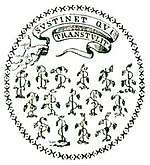Saybrook Colony
The Saybrook Colony was an English colony established in late 1635 at the mouth of the Connecticut River in present-day Old Saybrook, Connecticut by John Winthrop, the Younger, son of John Winthrop, the Governor of the Massachusetts Bay Colony. Winthrop the Younger was designated Governor by the original settlers, including Colonel George Fenwick and Captain Lion Gardiner. They claimed possession of the land via a deed of conveyance from Robert Rich, 2nd Earl of Warwick. The colony was named in honor of Lords Saye and Brooke, prominent Parliamentarians and holders of the colony's land grants.
Saybrook Colony | |||||||
|---|---|---|---|---|---|---|---|
| 1635–1644 | |||||||
 Coat of arms
| |||||||
 Map of Connecticut annotated to show its colonial history and the establishment of its modern borders | |||||||
| Status | Colony of England | ||||||
| Capital | Old Saybrook | ||||||
| Common languages | English | ||||||
| Government | Constitutional monarchy | ||||||
| History | |||||||
• Established | 1635 | ||||||
• merged with Connecticut Colony | 1644 | ||||||
| Currency | Pound sterling | ||||||
| |||||||
Early settlers of the colony were ardent supporters of Oliver Cromwell and of democracy. In the 1630s in what became Connecticut, it was rumored that Cromwell's emigration was imminent from England to Saybrook, along with the departure from Old England of other prominent Puritan sponsors of the colony, including John Pym, John Hampden, Arthur Haselrig, and Lords Saye and Brooke. Even as late as the 1770s, residents of Old Saybrook still talked about which town lots would be given to prominent Parliamentarians.
Settlement preparations included sending a ship with an unusual cargo of ironwork for a portcullis and drawbridges, and even an experienced military engineer.[2] Saybrook's fort was to be the strongest in New England. However, prominent Puritans soon "found the countrie [England] full of reports of their going" and were worried that they would not be allowed to sell their estates and take ship. By 1638, the plans for Saybrook were abandoned. Cromwell's financial difficulties had been cleared up by an inheritance and he moved from Huntingdon to nearby Ely. Thus, the sponsors remained in England and played their respective political and military roles in the English Civil War and its aftermath. As a consequence, the colony struggled and, by 1644, Fenwick agreed to merge the colony with the more vibrant Connecticut Colony a few miles up river.
In 1647, Major John Mason assumed command of Saybrook Fort, which controlled the main trade and supply route to the upper river valley. The fort mysteriously burned to the ground, but another improved fort was quickly built nearby. He spent the next twelve years there and served as Commissioner of the United Colonies, its chief military officer, Magistrate, and peacekeeper. He was continually called upon to fairly negotiate the purchase of Indian lands, write a treaty, or arbitrate some Indian quarrel, many of which were instigated by his friend Uncas.
See also
- Lower Connecticut River Valley – Connecticut planning region covering the area
References
- Alfred A. Young, "English Plebeian Culture and 18th Century American Radicalism" in Margret Jacob and James Jacob, eds., The Origins of Anglo American Radicalism (New Jersey: Humanities Press International, 1991), page 195
- Richard C. Dunn, Puritans and Yankees (Princeton: Princeton University Press, 1962)
Further reading
- Ward, Harry M. The United Colonies of New England, 1643–90 (Vantage Press, 1961).
- Andrews, Charles McLean. The Colonial Period of American History (Vol. II) – The Beginnings of Connecticut 1632–1662 (Tercentenary Commission Publication Vol. XXXII 1934).